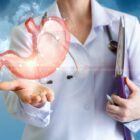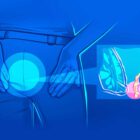Hemorrhoids (HEM-uh-roids), also called piles, are swollen veins in your anus and lower rectum, similar to varicose veins. Hemorrhoids can develop inside the rectum (internal hemorrhoids) or under the skin around the anus (external hemorrhoids).
What is Hemorrhoidal Disease ?
In some people, the hemorrhoidal vessels located around the rectum (anus) and the last part of the large intestine (rectum) are excessively enlarged and overflowing from the rectum (anus). For example, in individuals suffering from constipation, the stool hardens and the defecation function becomes harder. The individual needs excessive strain and has difficulty to discharge this hard stool. Meanwhile, the layers and veins covering the breech (anus) canal are damaged. This causes enlargement and swelling of the vessels. This enlargement and swelling of the vessels is called hemorrhoidal disease or, in short, hemorrhoids. In this case, the vessels cannot perform their normal functions and sometimes cause serious complaints.
Hemorrhoid disease may occur in both vascular networks. Therefore, the signs and symptoms of hemorrhoid disease occurring in these two vascular networks are different. Whichever vascular group (hemorrhoidal vascular group) is sick differs according to the signs and symptoms.
Hemorrhoid Nipples Going Out of Breech
Internal Hemorrhoids (Internal Hemorrhoidal Disease)
It develops from hemorrhoidal vessels located inside the anus (anus). Painless bleeding is the most important symptom. Sometimes internal hemorrhoids go out of the anus (anus) during defecation, and the patient complains of a swelling (breast) on his hand. In addition, internal hemorrhoids that come out during defecation and do not enter can cause pain. Sometimes these outside breasts become inflamed and can cause serious problems.
External Hemorrhoids (External Hemorrhoidal Disease)
External hemorrhoids, which are covered with a thin skin, are normally not felt. If a blood clot (thrombosis) forms inside these hemorrhoidal vessels, it will be quite painful. The patient tells that a hard and painful swelling (nipples) has come to his hand at the edge of his anus. This painful swelling (breast) filled with clot (thrombosed hemorrhoids) causes bleeding when it is ruptured.
Hemorrhoidal disease can sometimes affect both internal and external hemorrhoidal diseases, that is, both groups of vessels. In this case, signs and symptoms of both appear.
Internal and External Hemorrhoids
Generally, more than half of individuals over the age of 30 in the community have complaints about hemorrhoids at any time in their lives.
What are the symptoms of hemorrhoids ?
Bleeding During Defecation (Great Ablution)
It is the most important symptom of hemorrhoids disease. It is often fresh bright red color such as nosebleeds. Blood can be noticed on the stool and during cleaning, and the entire toilet can become contaminated with blood. In general, bleeding is painless.
Goat Going Out During Defecation (Making Great Ablution), Swelling
The patient complains of a soft swelling coming out of the anus, the mass (from the breast). Some patients may push this emerging swelling back into the breech.
Hemorrhoids With Bleeding
Itching in the Breech (Anal) Area
Hemoroidal damarların normal işlevlerini yapamaması ile makat bölgesinin hijyeni de bozulur. Makatın tam kapanmaması ile dışkı ve akıntı kaçağı olur. Buna bağlı olarak makat bölgesinde kaşıntı oluşur.
Ache
Patients cannot fully express these complaints. They can describe the pain as a feeling of tingling or rectal burning. Especially, external hemorrhoids thrombosed (blood clot formation in the vein) causes severe pain.
Swelling that is constantly outside the anal canal (breech) and painful to the touch
Pain may develop as a result of the protrusion of the internal hemorrhoids from the anus, as well as the thrombosis of the external hemorrhoids.
In addition, the weight, discharge, bleeding in the breech, bleeding or contamination with feces are other symptoms of hemorrhoids .
Causes of Hemorrhoidal Disease – Why Hemorrhoids ?
Standing Upright for a Long Time
Although the exact cause-effect relationship is not fully known, standing upright, unlike other living things, is thought to cause a great filling of blood and pressure in the breech veins (veins in the anus). This is a factor that facilitates the development of the disease.
Eating habits
Another important cause of hemorrhoids is the eating habit. With the development of the industry in the western society since the 20th century, the eating habits have also changed. As a result, dietary fiber (pulp) foods decreased. However, non-digestible fibers in the body absorb 30 times as much water and make the stool soft and shaped. Thus, defecation can be made easily, without forcing and straining. Otherwise, strain and strain will further increase the pressure in this area. As a result, hemorrhoids may develop. It is known that the incidence of hemorrhoids disease increases in the absence of fiber (pulp) foods in meals.
False Defecation Habits
Although most people have hemorrhoids, they do not change their defecation habits. Incorrect habits, such as the defecation habit being uneven or the defecation delayed voluntarily, cause the stool to harden. Straining during the defecation and long waiting in the toilet increases the enlargement of the hemorrhoidal vessels. During the passing of solid and hard stool through the anus, damage to these vessels occurs. Therefore, pain and sometimes bleeding occur.
Constipation
Another important factor in regulating the defecation habit is the amount of water drunk. Normally it is necessary to drink at least 8-10 glasses of water a day unless there is any disease that restricts water intake. Drinking a small amount of water can cause constipation. Since constipation will also cause strain, complaints of hemorrhoids may increase.
In addition, the factors that cause aggravation of the disease are as follows;
- Age
- Chronic (prolonged) constipation or diarrhea
- pregnancy
- Genetic causes (hereditary)
- Frequent use of drugs (laxatives and enemas) that facilitate defecation
- Tough and prolonged strains to defecate
- Sitting in the toilet for a long time (reading newspapers, books, etc.)
- Heavy lifting
- Consuming nutrients that cause aggravation of the disease (alcohol, spicy foods)
Whatever the reason, the tissues that support these vascular networks (veins in the breech canal) are stretched and as a result these vessels expand, the surrounding support tissue and walls become thinner and bleeding occurs. If tension increases, pressure continues, these thin veins come out of the anus.




